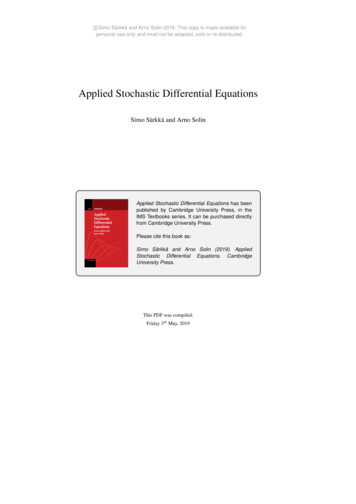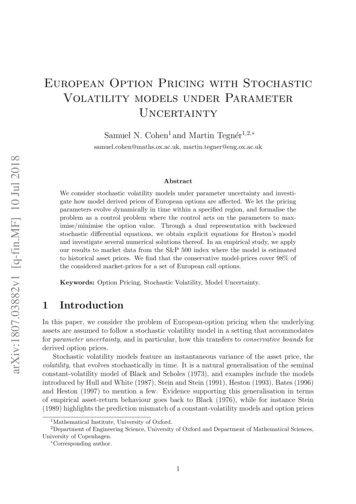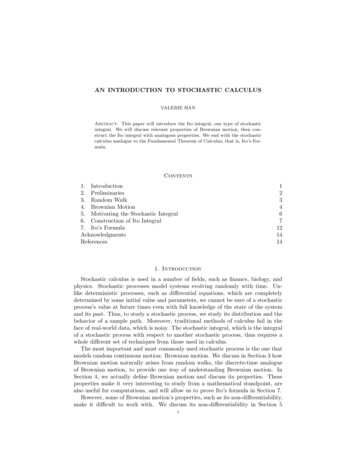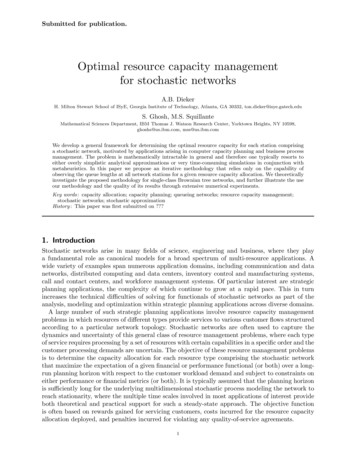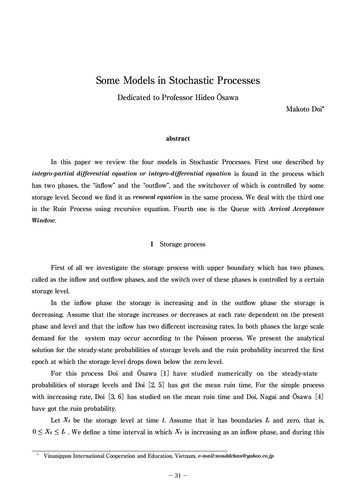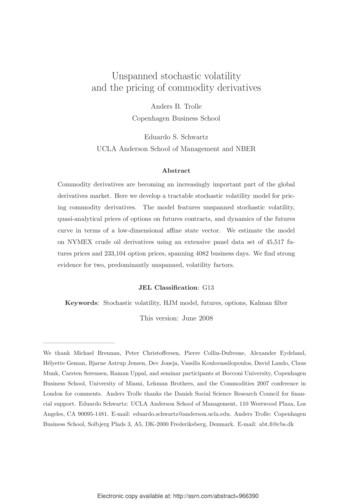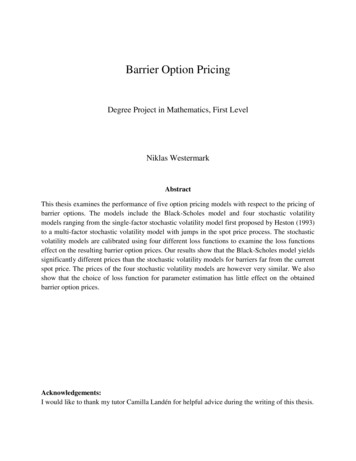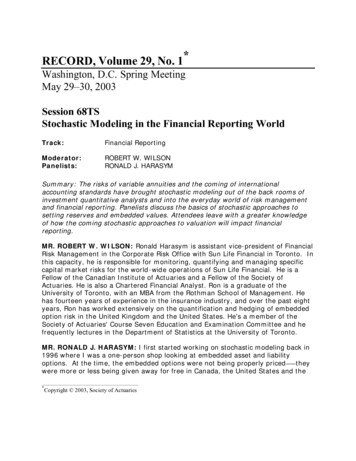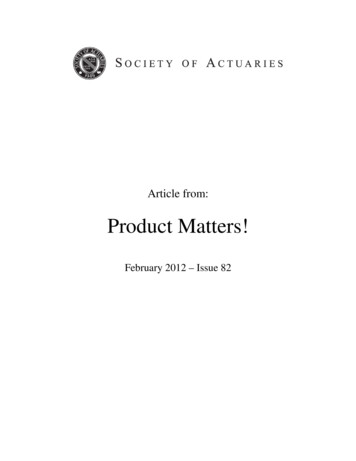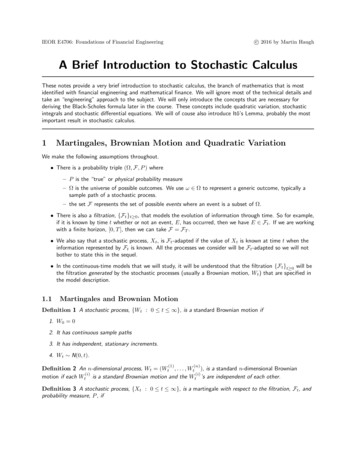
Transcription
c 2016 by Martin HaughIEOR E4706: Foundations of Financial EngineeringA Brief Introduction to Stochastic CalculusThese notes provide a very brief introduction to stochastic calculus, the branch of mathematics that is mostidentified with financial engineering and mathematical finance. We will ignore most of the technical details andtake an “engineering” approach to the subject. We will only introduce the concepts that are necessary forderiving the Black-Scholes formula later in the course. These concepts include quadratic variation, stochasticintegrals and stochastic differential equations. We will of couse also introduce Itô’s Lemma, probably the mostimportant result in stochastic calculus.1Martingales, Brownian Motion and Quadratic VariationWe make the following assumptions throughout. There is a probability triple (Ω, F, P ) where– P is the “true” or physical probability measure– Ω is the universe of possible outcomes. We use ω Ω to represent a generic outcome, typically asample path of a stochastic process.– the set F represents the set of possible events where an event is a subset of Ω. There is also a filtration, {Ft }t 0 , that models the evolution of information through time. So for example,if it is known by time t whether or not an event, E, has occurred, then we have E Ft . If we are workingwith a finite horizon, [0, T ], then we can take F FT . We also say that a stochastic process, Xt , is Ft -adapted if the value of Xt is known at time t when theinformation represented by Ft is known. All the processes we consider will be Ft -adapted so we will notbother to state this in the sequel. In the continuous-time models that we will study, it will be understood that the filtration {Ft }t 0 will bethe filtration generated by the stochastic processes (usually a Brownian motion, Wt ) that are specified inthe model description.1.1Martingales and Brownian MotionDefinition 1 A stochastic process, {Wt : 0 t }, is a standard Brownian motion if1. W0 02. It has continuous sample paths3. It has independent, stationary increments.4. Wt N(0, t).(1)(n)Definition 2 An n-dimensional process, Wt (Wt , . . . , Wt ), is a standard n-dimensional Brownian(i)(i)motion if each Wt is a standard Brownian motion and the Wt ’s are independent of each other.Definition 3 A stochastic process, {Xt : 0 t }, is a martingale with respect to the filtration, Ft , andprobability measure, P , if
A Brief Introduction to Stochastic Calculus21. EP [ Xt ] for all t 02. EP [Xt s Ft ] Xt for all t, s 0.Example 1 (Brownian martingales) Let Wt be a Brownian motion. Then Wt , Wt2 t and exp θWt θ2 t/2 are all martingales.The latter martingale is an example of an exponential martingale. Exponential martingales are of particularsignificance since they are positive and may be used to define new probability measures.Exercise 1 (Conditional expectations as martingales) Let Z be a random variable and setXt : E[Z Ft ]. Show that Xt is a martingale.1.2Quadratic VariationConsider a partition of the time interval, [0, T ] given by0 t0 t1 t2 . . . tn T.Let Xt be a Brownian motion and consider the sum of squared changesQn (T ) : nX2[ Xti ](1)i 1where Xti : Xti Xti 1 .Definition 4 (Quadratic Variation) The quadratic variation of a stochastic process, Xt , is equal to thelimit of Qn (T ) as t : maxi (ti ti 1 ) 0.Theorem 1 The quadratic variation of a Brownian motion is equal to T with probability 1.The functions with which you are normally familiar, e.g. continuous differentiable functions, have quadraticvariation equal to zero. Note that any continuous stochastic process or function1 that has non-zero quadraticvariation must have infinite total variation where the total variation of a process, Xt , on [0, T ] is defined asTotal Variation : lim t 0nX Xtk Xtk 1 .i 1This follows by observing thatnX(Xtk Xtk 1 )2 nXi 1i 1! Xtk Xtk 1 max Xtk Xtk 1 .1 k n(2)If we now let n in (2) then the continuity of Xt implies the impossibility of the process having finite totalvariation and non-zero quadratic variation. Theorem 1 therefore implies that the total variation of a Brownianmotion is infinite. We have the following important result which proves very useful if we need to price optionswhen there are multiple underlying Brownian motions, as is the case with quanto options for example.Theorem 2 (Levy’s Theorem) A continuous martingale is a Brownian motion if and only if its quadraticvariation over each interval [0, t] is equal to t.1Asample path of a stochastic process can be viewed as a function.
A Brief Introduction to Stochastic Calculus23Stochastic IntegralsWe now discuss the concept of a stochastic integral, ignoring the various technical conditions that are requiredto make our definitions rigorous. In this section, we write Xt (ω) instead of the usual Xt to emphasize that thequantities in question are stochastic.Definition 5 A stopping time of the filtration Ft is a random time, τ , such that the event {τ t} Ft for allt 0.In non-mathematical terms, we see that a stopping time is a random time whose value is part of the informationaccumulated by that time.Definition 6 We say a process, ht (ω), is elementary if it is piece-wise constant so that there exists a sequenceof stopping times 0 t0 t1 . . . tn T and a set of Fti -measurable2 functions, ei (ω), such thatXei (ω)I[ti ,ti 1 ) (t)ht (ω) iwhere I[ti ,ti 1 ) (t) 1 if t [ti , ti 1 ) and 0 otherwise.Definition 7 The stochastic integral of an elementary function, ht (ω), with respect to a Brownian motion,Wt , is defined asZ Tn 1X ht (ω) dWt (ω) : ei (ω) Wti 1 (ω) Wti (ω) .(3)0i 0Note that our definition of an elementary function assumes that the function, ht (ω), is evaluated at theleft-hand point of the interval in which t falls. This is a key component in the definition of the stochasticintegral: without it the results below would no longer hold. Moreover, defining the stochastic integral in thisway makes the resulting theory suitable for financial applications. In particular, if we interpret ht (ω) as a tradingstrategy and the stochastic integral as the gains or losses from this trading strategy, then evaluating ht (ω) atthe left-hand point is equivalent to imposing the non-anticipativity of the trading strategy, a property that wealways wish to impose.For a more general process, Xt (ω), we haveZTZXt (ω) dWt (ω) : limn 0(n)where XtT(n)Xt (ω) dWt (ω)0is a sequence of elementary processes that converges (in an appropriate manner) to Xt .Example 2 We want to computepartition of [0, T ] and defineRT0Wt dWt . Towards this end, let 0 tn0 tn1 tn2 . . . tnn T be aXtn : n 1XWtni I[tni ,tni 1 ) (t)i 0where I[tni ,tni 1 ) (t) 1 if t [tni , tni 1 ) and is 0 otherwise. Then Xtn is an adapted elementary process and, bycontinuity of Brownian motion, satisfies limn Xtn Wt almost surely as maxi tni 1 tni 0. The2 Looselyspeaking, a function f (ω) is Ft measurable if its value is known by time t.
A Brief Introduction to Stochastic Calculus4stochastic integral of Xtn is given byZn 1XTXtn dWt 0Wtni (Wtni 1 Wtni )i 0 n 1 1 X 2Wtni 1 Wt2ni (Wtni 1 Wtni )22 i 0 n 11 2 1 21XWT W0 (Wtni 1 Wtni )2 .222 i 0(4)By Theorem 1 the sum on the right-hand-side of (4) converges in probability to T as n . And sinceW0 0 we obtainZ TZ T11Xtn dWt WT2 T.Wt dWt limn 2200Note that we will generally evaluate stochastic integrals using Itô’s Lemma (to be discussed later) withouthaving to take limits of elementary processes as we did in Example 2.Definition 8 We define the space L2 [0, T ] to be the space of processes, Xt (ω), such that"Z#TXt (ω)2 dt .E0Theorem 3 (Itô’s Isometry) For any Xt (ω) L2 [0, T ] we have !2 "Z#Z TT2E Xt (ω) dWt (ω) EXt (ω) dt .00Proof: (ForP the case where Xt is an elementary process)Let Xt i ei (ω)I[ti ,ti 1 ) (t) be an elementary process where the ei (ω)’s and ti ’s are as defined in Definition 6. RTPn 1We therefore have 0 Xt (ω) dWt (ω) : i 0 ei (ω) Wti 1 (ω) Wti (ω) . We then have !2 !2 Z Tn 1X E Xt (ω) dWt (ω) E ei (ω) Wti 1 (ω) Wti (ω)0i 0 n 1Xh 2 iE e2i (ω) Wti 1 (ω) Wti (ω)i 0n 1X 2 E ei ej (ω) Wti 1 (ω) Wti (ω) Wtj 1 (ω) Wtj (ω)0 i j n 1 n 1Xh 2 2 i E e(ω)EW(ω) W(ω)tttiii 1i {z} i 0 ti 1 ti 2n 1X E ei ej (ω) Wti 1 (ω) Wti (ω) Etj Wtj 1 (ω) Wtj (ω) {z} 0 i j n 1 0
A Brief Introduction to Stochastic Calculus E"n 1X5#e2i (ω)(ti 1 ti )i 0"Z E#TXt (ω)2 dt0which is what we had to show.Theorem 4 (Martingale Property of Stochastic Integrals) The stochastic integral,RtYt : 0 Xs (ω) dWs (ω), is a martingale for any Xt (ω) L2 [0, T ].RtExercise 2 Check that 0 Xs (ω) dWt (ω) is indeed a martingale when Xt is an elementary process. (Hint:Follow the steps we took in our proof of Theorem 3.)2.1Stochastic Differential EquationsDefinition 9 An n-dimensional Itô process, Xt , is a process that can be represented asZ tZ tXt X0 as ds bs dWs0(5)0where W is an m-dimensional standard Brownian motion, and a and b are n-dimensional and n m-dimensionalFt -adapted3 processes, respectively4 .We often use the notationdXt at dt bt dWtas shorthand for (5). An n-dimensional stochastic differential equation (SDE) has the formdXt a(Xt , t) dt b(Xt , t) dWt ;X0 xwhere as before, Wt is an m-dimensional standard Brownian motion, and a and b are n-dimensional andn m-dimensional adapted processes, respectively. Once again, (6) is shorthand forZ tZ tXt x a(Xs , s) dt b(Xs , t) dWs .0(6)(7)0While we do not discuss the issue here, various conditions exist to guarantee existence and uniqueness ofsolutions to (7). A useful tool for solving SDE’s is Itô’s Lemma which we now discuss.3Itô’s LemmaItô’s Lemma is the most important result in stochastic calculus, the “sine qua non” of the field. We first stateand give an outline proof of a basic form of the result.Theorem 5 (Itô’s Lemma for 1-dimensional Brownian Motion)Let Wt be a Brownian motion on [0, T ] and suppose f (x) is a twice continuously differentiable function on R.Then for any t T we haveZ tZ t1f 00 (Ws ) ds f 0 (Ws ) dWs .(8)f (Wt ) f (0) 2 003 a and b are F -‘adapted’ if atttt4 Additional technical conditionsand bt are Ft -measurable for all t. We always assume that our processes are Ft -adapted.on at and bt are also necessary.
A Brief Introduction to Stochastic Calculus6Proof: (Sketch) Let 0 t0 t1 t2 . . . tn t be a partition of [0, t]. Clearlyf (Wt ) f (0) n 1X f (Wti 1 ) f (Wti ) .(9)i 0Taylor’s Theorem impliesf (Wti 1 ) f (Wti ) f 0 (Wti )(Wti 1 Wti ) 1 00f (θi )(Wti 1 Wti )22(10)for some θi (Wti , Wti 1 ). Substituting (10) into (9) we obtainf (Wt ) f (0) n 1X0f (Wti )(Wti 1i 0n 11 X 00f (θi )(Wti 1 Wti )2 . Wti ) 2 i 0(11)If we let δ : maxi ti 1 ti 0 then it can be shown that the terms on the right-hand-side of (11) convergeto the corresponding terms on the right-hand-side of (8) as desired. (This should not be surprising as we knowthe quadratic variation of Brownian motion on [0, t] is equal to t.)A more general version of Itô’s Lemma can be stated for Itô processes.Theorem 6 (Itô’s Lemma for 1-dimensional Itô process)Let Xt be a 1-dimensional Itô process satisfying the SDEdXt µt dt σt dWt .If f (t, x) : [0, ) R R is a C 1,2 function and Zt : f (t, Xt ) thendZt 3.1 f f1 2f(t, Xt ) dt (t, Xt ) dXt (t, Xt ) (dXt )2 t x2 x2 f f1 2f f2(t, Xt ) σt dt (t, Xt ) (t, Xt ) µt (t, Xt ) σt dWt . t x2 x2 xThe “Box” CalculusIn the statement of Itô’s Lemma, we implicitly assumed that (dXt )2 σt2 dt. The “box calculus” is a series ofsimple rules for calculating such quantities. In particular, we use the rulesdt dt dt dWtdWt dWt 0 and dtwhen determining quantities such as (dXt )2 in the statement of Itô’s Lemma above. Note that these rules are(1)(2)consistent with Theorem 1. When we have two correlated Brownian motions, Wt and Wt , with correlation(1)(2)coefficient, ρt , then we easily obtain that dWt dWt ρt dt. We use the box calculus for computing thequadratic variation of Itô processes.(1)Exercise 3 Let Wt(2)and Wtbe two independent Brownian motions. Use Levy’s Theorem to show thatp(1)(2)Wt : ρ Wt 1 ρ2 Wtis also a Brownian motion for a given constant, ρ.
A Brief Introduction to Stochastic Calculus3.27Some ExamplesExample 3 Suppose a stock price, St , satisfies the SDEdSt µt St dt σt St dWt .Then we can use the substitution, Yt log(St ) and Itô’s Lemma applied to the function5 f (x) : log(x) toobtain Z tZ t2(µs σs /2) ds σs dWs .(12)St S0 exp00Note that St does not appear on the right-hand-side of (12) so that we have indeed solved the SDE. Whenµs µ and σs σ are constants we obtain St S0 exp (µ σ 2 /2) t σ dWt(13) so that log(St ) N (µ σ 2 /2)t, σ 2 t .Example 4 (Ornstein-Uhlenbeck Process)Let St be a security price and suppose Xt log(St ) satisfies the SDEdXt [ γ(Xt µt) µ] dt σdWt .Then we can apply Itô’s Lemma to Yt : exp(γt)Xt to obtaindYt exp(γt) dXt Xt d (exp(γt)) exp(γt) ([ γ(Xt µt) µ] dt σdWt ) Xt γ exp(γt) dt exp(γt) ([γµt µ] dt σdWt )so thatZYt Y0 µteγs (γs 1) ds σ0Zteγs dWs(14)0or alternatively (after simplifying the Riemann integral in (14))Xt X0 e γt µt σe γttZeγs dWs .(15)0Once again, note that Xt does not appear on the right-hand-side of (15) so that we have indeed solved theSDE. We also obtain E[Xt ] X0 e γt µt and" Z 2 #Z tt γtγs2 2γtγsVar(Xt ) Var σee dWs σ eEe dWs00 σ 2 e 2γtZte2γs ds(by Itô’s Isometry)0 σ22γ 1 e 2γt .These moments should be compared with the corresponding moments for log(St ) in the previous example.5 Notethat f (·) is not a function of t.
A Brief Introduction to Stochastic Calculus 3 2 Stochastic Integrals We now discuss the concept of a stochastic integral, ignoring the various technical conditions that are required to make our de nitions rigorous. In this section, we write X t(!) instead of the usual X tto emphasize that the quantities in question are stochastic.
